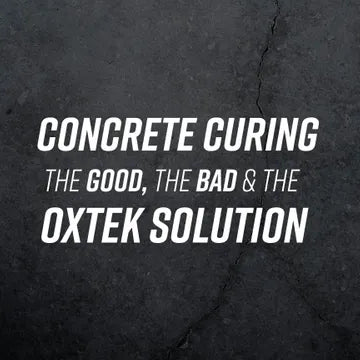In order for your concrete project to be successful, curing is undoubtedly required. Knowing that is easy, choosing the right system for your project however is a hard decision and requires careful scrutiny of all the variables in the project. Curing is extremely important as it's required to ensure your concrete gains the required strength and resistance to abrasion. In this blog we'll take a look at some of those variables and how they effect choosing the right system for your project. We'll also introduce you to a couple of alternate products that are sure to become a regular in your concrete curing arsenal.
Concrete Curing - What happens when you skip this crucial step.
A lack of concrete curing is the number 1 cause of premature deterioration of concrete, signs of this include shrinkage cracks as well as weak powdery surfaces with low abrasion resistance. For obvious reasons, it's not a step you want to skip if the long term success of your construction project is of importance.
What concrete curing systems are currently available?
There are many methods of concrete curing, each of which has their own pro's and cons. Although, the choice is usually based around the site restrictions as well as construction methodology, it's commonly accepted that water ponding will yield the greatest result. Unfortunately however, water ponding comes with its own issues and complications. Usually water ponding is ditched in favour of less effective methods due to the associated economical and logistical issues.
Other curing methods include; air, water ponding, plastic sheet, membrane forming compounds or with chemical applications. The most common of which, membrane forming compounds are often formulated from wax emulsions, chlorinated rubbers, synthetic and natural resins, as well as PVA based emulsions. They're normally applied in spray form directly to the concrete, followed by drying time to allow the subsequent nearly impermeable membrane to form. This membrane hinders the loss of moisture creating a stronger concrete.
The problem with membrane forming compounds.
Commonly, the membrane will cause adhesion issues between it and the following flooring to be applied. Tile adhesive, direct stick carpet and vinyl, epoxy and polyurethane coatings will all require the membrane to be removed. We've even seen issues arise simply from the remaining residue left behind by these membrane forming coatings. Obviously the removal and potential grinding required after removal of these membrane forming compounds will add significant costs to the curing process which is why there are also UV degrading curing compounds available on the market.

Oxtek solutions it seems, has the solution.
First, lets take a look at the company behind the product. We won't dig too deep, but it's good to know a little about the company you're supporting. Oxtek initially started in 1998 under the trading name Protect Crete. That makes 25 years under their belt so you know they must be doing something right. They're Australian owned and base their operations out of Melbourne in order to service Australia, New Zealand and Asia. Oxtek also boast some of the most impressive service around; if you're in Australia or NZ, you can call Oxtek to arrange face to face assistance when you're struggling with challenges on your site.
Alright, now that's out of the way, we can get to the product/s. In reality, Oxtek offer a huge range, but for this we'll be narrowing the focus to just two of their concrete curing options. The concrete curers we'll be looking at are the X200 Densi-Proof as well as the X220 Moisture Fix. Although they're both concrete curing products, they do have a few key differences.
Oxtek solutions | X200 Densi-Proof.
According to their website, the key benefits to the X200 Densi-Proof are;
- Forms a permanent internal moisture barrier in the concrete, eliminating the risk of moisture compromising floor coverings, coatings, adhesives and sealers
- Cures, Densifies, Hardens and Waterproofs concrete up to 200mm
- Ideally applied as a cure at time of pour by spray
- Can be applied to existing if clean and porous
- Acts as an internal moisture barrier for Floor coverings and Topical Coatings
- Application of Vinyl & Topical Coatings 2 weeks after pour or next day on existing
- System included in AS1884-2021 Floor Coverings-Resilient Sheet & Tiles – Installation Practises
- Environmentally Friendly & HACCP Certified – Low Odour – LOW VOC
- Warranty of up to 15 years, supported by project specification & robust QC $ QA procedures
These alone are some impressive features, but I decided to dig a little deeper and came up with a few other features that I think make the X200 Densi-Proof concrete curer a product definitely worth considering.
According to a case study and testimonial to back it up. X200 Densi-Proof can be applied to a 30+ year old concrete slab, provided the deterioration and shrinkage cracks have been appropriately repaired. Any sealers or coatings will have to be removed as well. You can achieve this quickly and cost effectively using a 3 phase grinder like the Schwamborn DSM530S.
I've also read that X200 Densi-Proof will cure new concrete to the same level as the industry leading method, water-ponding. That's an impressive claim and as far as I can tell, there's nothing to say that it won't. So with that in mind, X200 Densi-Proof should definitely be on the consideration list for your next project.
During my digging I found some impressive photo's from a case study done by "Raw Surfaces" in 2021. They used X200 to give the slab the required strength and abrasion resistance. Followed by a Seal and Polish. The art of polishing concrete is complicated, Pyrafloor offer a fantastic 2 day course to learn how to do this. Check it out below.
Oxtek solutions | X220 Moisture Fix.
Again, according to the Oxtek solutions website, the key benefits to X220 Moisture Fix are;
- Densifies, Hardens and Waterproofs concrete
- Designed for existing projects with high moisture content
- Can be applied as a curing regime at time of pour by spray
- Doesn’t form a membrane – After trade friendly (Epoxy, Adhesives, Levelling Compounds)
- System included in AS1884-2021 Floor Coverings-Resilient Sheet & Tiles – Installation Practises
- Environmentally Friendly & HACCP Certified – Low Odour – LOW VOC
- Warranties of up to 15 years, supported by project specification and robust QC & QA procedures
An impressive list, but during my search. I came up with a couple of other benefits that are worth mentioning.
From what I undestand X220 Moisture Fix is designed primarily as curing and waterproofing agent for subfloor concrete slabs with moisture problems. It's also been formulated to applied to existing concrete rather than new, which is why X220 can be applied by pouring/broom spread as well as via spray applicator.
On top of all this, the stand out feature from my research is the drying time. For existing concrete, foot traffic is accepted just 1 hour after application! That's a feature that bigger projects could benefit from. If the project is planning to have a topical coating or flooring system of some description, then that can be applied/installed just 24hours (in most cases) after X220 Moisture Fix has been put down.
Again this list of features should definitely mean X220 is a top contender when deciding what curing method to use on your next project!
The Museum of Contemporary Art in NSW made use of X220 to ensure a strong concrete capable of dealing with signifcant foot traffic as well as some machinery.
Let's summarise.
Although there are many ways of curing concrete, there is no argument the process warrants careful consideration on every project. If strength and durability are important it's a crucial step that shouldn't be skipped. Although there are many different solutions, Oxtek offer a few different options that won't form a membrane and will therefore save significant cost and time in your project. It's environmentally friendly and odourless, plus has many additional benefits that conventional curing solutions are unlikely to offer.
If you've decided you'd like to get your hands on some Oxtek X200 Densi-Proof or X220 Moisture-Fix. The team at All Preparation Equipment can help. Drop us a line on 1800 422 992 to discuss your next project.


 Store Locator
Store Locator Login
Login
 Cart
Cart




